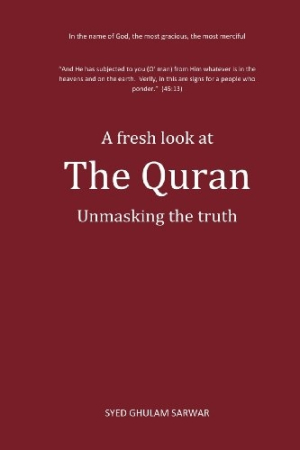A fresh look at The Quran
Unmasking the truth
The mystical language of this overview of the Quran will intrigue as it informs.
Veteran journalist Syed Ghulam Sarwar embarks on a layman’s interpretation of the Quran, aiming to get back to its initial purposes and free it from the bonds of ritual. The result is an intelligent and intriguing experiment in religious thought.
“Spiritual in origin and divinely inspired,” Sarwar asserts, “the Quran presents a secular program of action based on lofty morality rooted in faith in God.” This tension between holiness and secularity is maintained throughout. Sarwar’s pages alternate between reflections on Islam’s roots in history, refutations of mythology built into it by adherents after Muhammad’s death, and the reintroduction of quasi-mystical concepts of the tradition.
All religions have their roots in revolution, Sarwar suggests, and began with individuals who earnestly wanted to better the world. Some of these people were prophets or missionaries of God—“malaekah” in the Quran’s parlance, though Sarwar refutes the translation of the word as “angels.” Sarwar maintains the doctrine that Muhammad was the last of these, but says that all were moved by a divine spirit that charged them to urge souls toward harmonious interactions with other souls, toward salvation through right action rather than damnation born of cruelty and ignorance.
Such pages have moments that verge on the mystical. Sarwar’s diction becomes like a dance. A discussion of God’s oneness, for example, includes phrasing like, “time, space and number are … one flow, one expanse and one unbroken stretch … The infinitude and oneness of each constituent of the universe … are part reflection of the infinitude and oneness of God.”
But Sarwar holds himself apart from Sufi mystics; this is, we’re reminded, a project about Islam at its origins, before logical occurrences had been repackaged as miracles and prophets as gods. Some of these reminders are Muslim doctrine—that Jesus was a reformer who challenged the status quo but didn’t rise from the dead like a deity—while other moments chart less familiar territory—that Jesus continued preaching into the period of Paul, or that Noah’s “ark” was actually a conquering army. Such suppositions are reliant on translations that eschew miracles for reasonable explanations. If they do not convince readers, they will at least provide a space for intellectual engagement.
From the first, Sarwar presents combating the ossification of the Quran as one of his primary goals, expressing dismay for the way it’s been maltreated and misused. The lofty visions for human betterment at its core faded into excuses for ignorance and darkness, he suggests. The determination with which he confronts and challenges mythologies built around translations does effectively muddle that picture; in that sense, the project may achieve some of its ends.
Even if its ideas fail to sway all adherents or to shape the way non-Muslims read the Quran, this layman’s effort should be praised both for its audacity and its argumentative prowess, as well as for the humanitarian consciousness that underlies both.
Reviewed by
Michelle Anne Schingler
Disclosure: This article is not an endorsement, but a review. The publisher of this book provided free copies of the book and paid a small fee to have their book reviewed by a professional reviewer. Foreword Reviews and Clarion Reviews make no guarantee that the publisher will receive a positive review. Foreword Magazine, Inc. is disclosing this in accordance with the Federal Trade Commission’s 16 CFR, Part 255.

